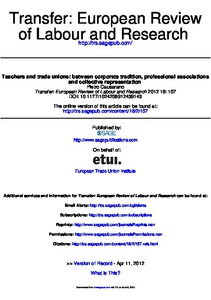Teachers and trade unions: between corporate tradition, professional associations and collective representation

Transfer. European Review of Labour and Research
2012
18
2
May
157-170
collective bargaining ; history ; occupational organization ; teacher ; trade unionism ; trade union
Trade unionism
http://dx.doi.org/10.1177/1024258912439143
English
Bibliogr.
"This article asks to what extent trade union culture among teaching staff reveals common elements both among teachers and within national contexts. Many elements – the development of school systems, cultural, religious and political distinctions, the differences between teachers' professional backgrounds, and their views of themselves as professionals or as officials – make it awkward to adopt a common reading of their trade union identities and activities. For this reason, national trajectories remain solidly in place. Following the Second World War, however, mass school attendance, the rise in educational levels and the social opening-up of school systems did profoundly alter the organization and culture of teaching activity. Elements of convergence then became apparent amidst the differences between the specific corporate traditions bringing the previously association-based system closer to general trade unionism: the federal structure and potential membership of a confederation; reliance on collective bargaining and negotiations; strikes; concertation and the use of bilateral instruments to manage and reform school establishments. "
Digital;Paper
The ETUI is co-funded by the European Union. Views and opinions expressed are however those of the author(s) only and do not necessarily reflect those of the European Union or the ETUI.